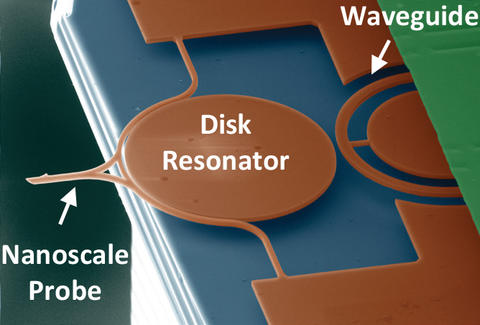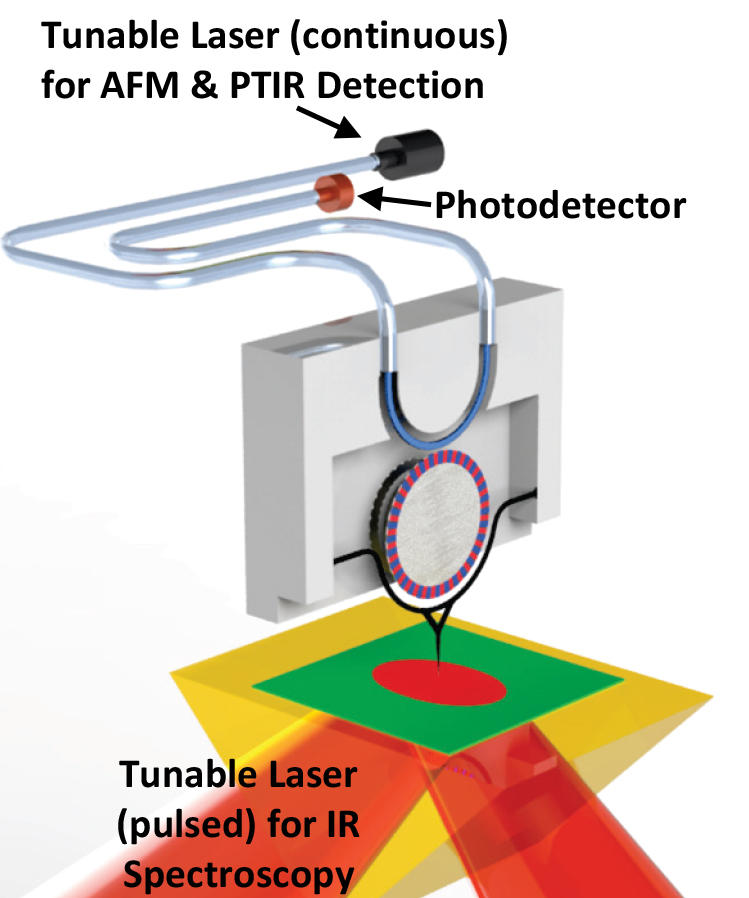NIST Researchers Revolutionize the Atomic Force Microscope
Nanoscale probe combined with optical “whispering gallery” makes the difference.

Colorized electron micrograph of a nanoscale AFM probe integrated with an optical resonator to expand the probe's capabilities. The disk resonator acts as an optical version of a "whispering gallery" that allows certain frequencies of light to resonate.
Most measuring instruments are limited by the tradeoff between how precisely and how rapidly a measurement is made: the more precise the measurement, the longer it takes. But because many phenomena occurring at the nanoscale are both rapid and tiny, they demand a measuring system that can capture their precise details in both time and space.
Taking up that challenge, researchers at the National Institute of Standards and Technology (NIST) have redesigned the detection system at the heart of the atomic force microscope (AFM). A premier tool of the nanoworld, the AFM uses a small probe, or tip, to map the submicroscopic hills and valleys that define the surface of materials, along with other properties, at the nanometer scale. Although the AFM has already revolutionized the understanding of nanostructures, scientists are now eager to study nanoscale phenomena, such as the folding of proteins or the diffusion of heat, which happen too quickly and generate changes too small to be accurately measured by existing versions of the microscope.
By fabricating an extremely lightweight AFM probe and combining it with a nanoscale device that converts minuscule deflections of the probe into large changes of an optical signal inside a waveguide, the NIST researchers have broken new ground: Their AFM system measures rapid changes in structure with high precision.

The achievement takes the AFM into a new realm, enabling the instrument to measure time-varying nanoscale processes that may change as quickly as ten billionths of a second. “This is truly a transformational advance,” said NIST scientist Andrea Centrone.
Centrone, Vladimir Aksyuk, and their colleagues employed the new AFM capabilities in experiments using photothermal induced resonance (PTIR), a technique that combines the acuity of an AFM with the ability to determine the composition of materials using infrared light.
With the new AFM-PTIR system, the scientists measured with high precision the rapid, but minute expansion of individual microcrystals heated by a light pulse. The microcrystals examined by the team belong to a class of materials known as metal-organic frameworks (MOFs). These materials contain nanosized pores that act as miniature sponges, which can store gas and serve as drug delivery containers, among other applications.
Accurate knowledge of how well MOFs conduct heat is crucial for designing these materials for specific applications. However, most MOFs are microcrystals, which are too small for conventional instruments to measure their thermal conductivity. Instead, the team used the new AFM-PTIR system to record how long it took for the MOF crystals to cool down and return to their original size after they were heated by the light pulse and thermally expanded. The researchers then used that information to determine the thermal conductivity of individual MOF microcrystals, a feat that had never before been accomplished.
The AFM system designed by Aksyuk and his colleagues features two key elements. First, the researchers shrunk and slimmed down the AFM’s probe, a small cantilever that acts like a spring, deflecting and vibrating when a sample exerts a force on it. Fashioned in the NanoFab at NIST’s Center for Nanoscale Science and Technology (CNST), the new probe weighs a mere trillionth of a gram. The minuscule mass enabled the probe to respond more quickly to a tiny force or displacement such as the one induced by the thermal expansion of the MOF the team examined.
The researchers integrated the cantilever with a miniature disk resonator that acts like an optical version of a whispering gallery. Just as a whispering gallery allows certain frequencies of sound waves to travel freely around a dome, the resonator allows certain frequencies of light to circulate around the disk.
The AFM cantilever and the disk are separated by a mere 150 nanometers. That’s close enough that tiny motions of the cantilever change the resonant frequencies in the disk, in effect transforming the small mechanical motion of the AFM probe into a large change in optical signal. Although scientists have combined optical cavities with other measuring tools, the team’s system is the first to integrate this kind of optical device in an AFM.
Centrone, Aksyuk and their colleagues described the findings in a recent publication in Nano Letters.
Aksyuk and his collaborators painstakingly designed, fabricated and tested the system using an array of nanofabrication tools at the CNST. The new AFM-PTIR system can record a displacement as small as a trillionth of a meter that occurs over a time scale as short as 10 billionths of a second. The team now plans to work on increasing the speed of the PTIR technique and using the probe to make measurements in water, a more suitable environment for examining biological samples.
Paper: J. Chae, S. An, G. Ramer, V. Stavila, G. Holland, Yohan Yoon, A.A. Talin, M. Allendorf, V.A. Aksyuk and A. Centrone. Nanophotonic Atomic Force Microscope Transducers Enable Chemical Composition and Thermal Conductivity Measurements at the Nanoscale. Nano Letters. Published online 3 August 2017. DOI: 10.1021/acs.nanolett.7b02404

